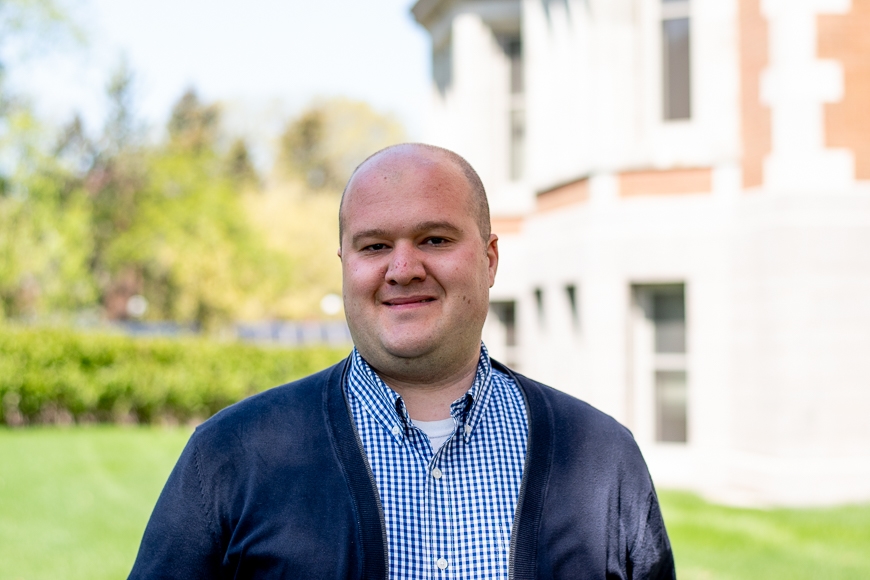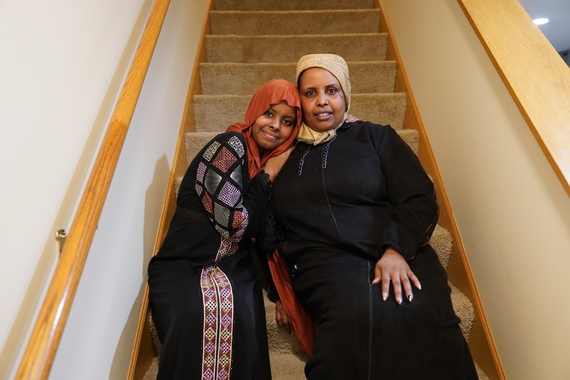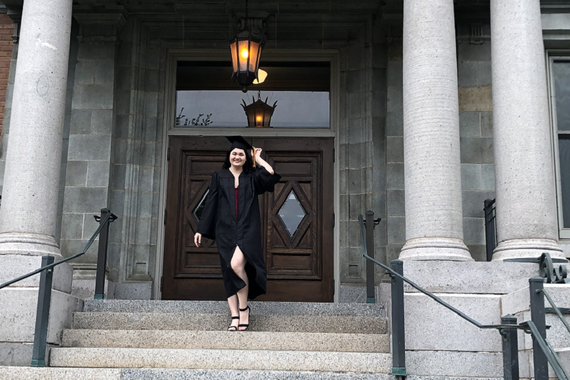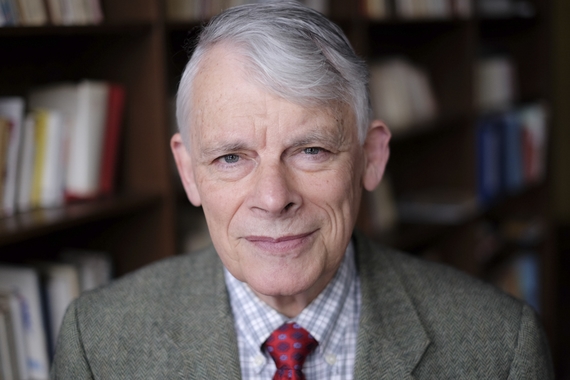Translating Culture: Archival Research in German & Yiddish Texts
PhD candidate Meyer Weinshel studies how Yiddish translations of German poetry shaped modern Jewish cultural developments. He spent fall 2018 conducting archival research at the National Library of Israel in Jerusalem, working closely with manuscripts and translations of German literature into Yiddish. Weinshel is a 2019-20 recipient of the Doctoral Dissertation Fellowship (DDF), which gives the University’s most accomplished PhD candidates the opportunity to devote a year to full-time research. He discusses how he fell in love with the languages he studies, the importance of intercultural literacy and multilingualism, and his involvement with Yiddish language pedagogy and revival.
What brought you to the University of Minnesota?
I came to the University of Minnesota because I was drawn to CLA research centers on campus (e.g. the Center for Austrian Studies, Center for Jewish Studies, Center for Holocaust and Genocide Studies, and the DAAD Center for German and European Studies). The presence of these centers reflected support for instructors and researchers specializing in Central European studies. Other important factors were, of course, graduate advising and funding opportunities for PhD students.
How did you become interested in German and Yiddish?
It was quite utilitarian at first. As is often the case, I began learning German in high school and had to complete a foreign language requirement as an undergraduate at Macalester. I was certainly interested in learning another language and studying abroad, but other factors were at play. I grew up in an Ashkenazi Jewish household, and the relationship to German and German-speaking culture wasn’t entirely positive. It didn’t take long to see how much the study of German and German-speaking cultures intersected with my interest in history and discourses surrounding the past. I declared my German major in my second semester of college and spent the next four years interweaving the study of language, literature, and culture more broadly with historical writing.
Yiddish, too, began as a requirement, but this time for the PhD. (PhD students in my program need to learn a third language to an equally high degree of proficiency or gain reading knowledge in two others.) Within a week of intensive language coursework at YIVO (The Institute for Jewish Research) in New York, I was hooked. An entire world opened up to me, and I knew Yiddish was going to become a central component of my doctoral work.
How does your graduate minor in history complement your work in Germanic studies?
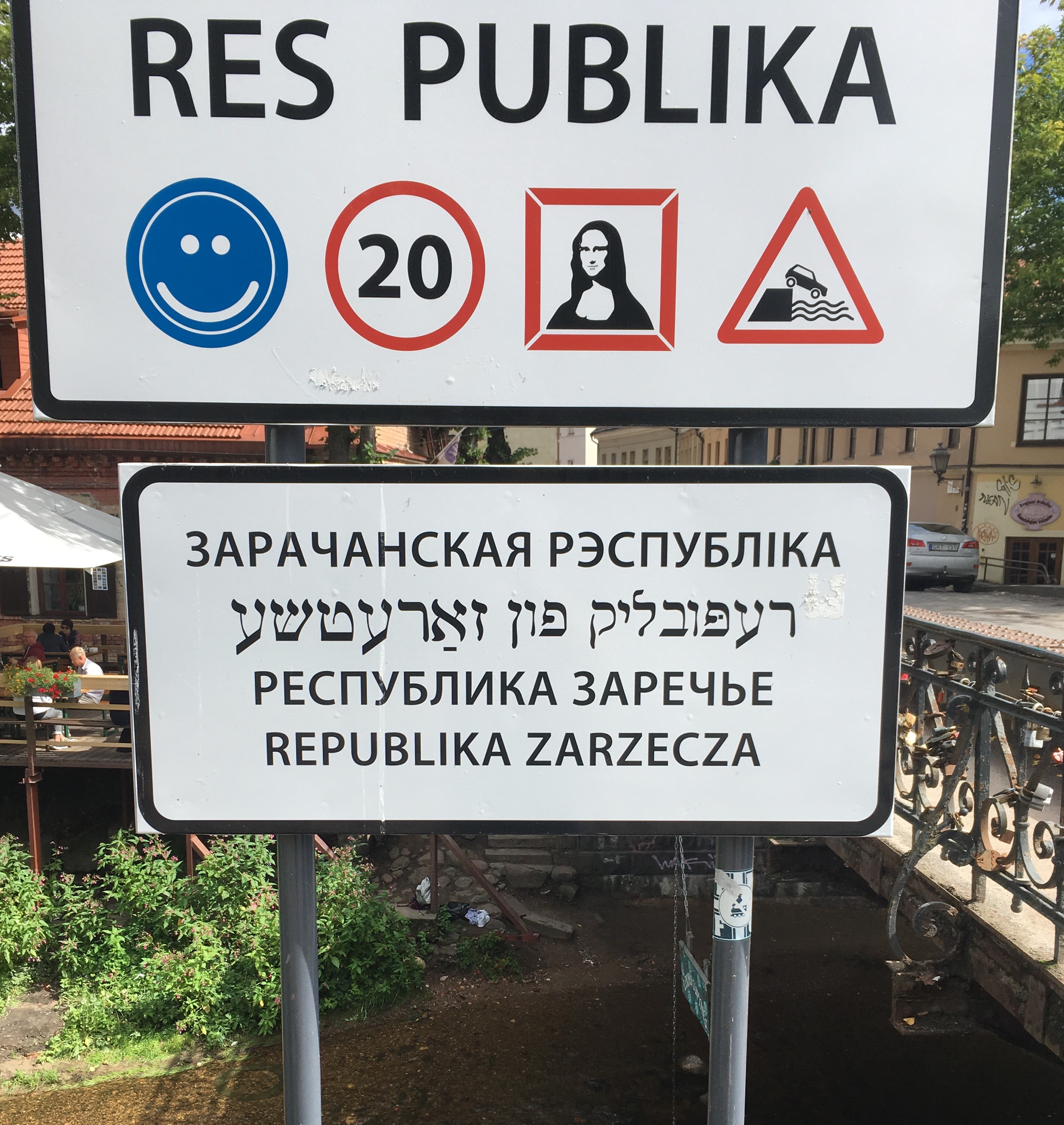
Unsurprisingly, my graduate minor in history became central to my work thanks to Jewish studies. Historical study and memory were (and are) central to Jewish cultures around the world. And most concretely: it’s difficult for students to conceptualize facets of cultures affected by genocide without access to the historical narratives produced by the affected groups. That is certainly the case for German-speaking Jewry, but it is crucial for Yiddish studies when little has actually been translated to other languages and few have fluency in Yiddish today.
What did you do in a typical day working in the archives in Jerusalem? What kinds of materials did you work with?
Several archives important for my dissertation research are housed at the National Library of Israel. Although the library is set to move to a new building in 2020 (across from the Knesset, the Israeli Parliament), it is currently at Hebrew University’s Givat Ram campus in West Jerusalem. I was also learning Hebrew at the time; I would generally spend several hours doing that two to three mornings a week, dividing the time between archival finding aids and viewing materials in the library. On alternate days, I would attend class on the other side of the city before heading back to the archive in the afternoon.
The materials I worked with varied from personal correspondence to unpublished manuscripts and translations of modern German literature into Yiddish. It took a lot of Sitzfleisch (the ability to sit for hours at a time) to focus and comb through catalogs and finding aids. Archival work is enjoyable because you learn how to critically engage with the highly selective, curated materials a person leaves behind that can hold a lot of sway over their legacy. As such, archives and the role of the Nachlass are very complicated—especially in a contested place like Israel/Palestine. The recent controversy surrounding the National Library of Israel and Kafka’s papers attest to this.
Why is it important to study translation? What can the historical translations you study teach us in the present day?
The translators and works I study traversed multiple continents and reached audiences around the world, and their archives contain materials that attest to this. They contain everything from works written in North America to Yiddish press releases from Eastern Europe and travelogues from Argentina and Australia. However, this literary and cultural interaction between German and Yiddish speakers does not often make it into curricula or popular consciousness. And yet, it reflects a common reality: “culture” transcends national borders and has a life (and afterlife) of its own. This is certainly the case when discussing immigration and exile of Central and Eastern European Jews, and the same is true for refugees experiencing similar upheaval today.
The study of translation also highlights the need for intercultural literacy and multilingualism. But sadly, when discussing the role of immigration today, skills of speaking and reading in another language are often labeled as liabilities by a majority culture, rather than as assets. Stories from émigrés abound about native languages being confined to the home or even being lost due to forced displacement, state repression, cultural attitudes, etc. As instructors and researchers of languages and cultures, it’s crucial to remind our students—and the American public—of an ethical component: making foreign language more visible in a society that is and always has been diverse, multilingual, and global.
“Translation” (both of literature and adapting cultural norms more broadly to a wider audience), and the in/visibility of translation often says a lot about the health of a society as a whole. For example, why were Yiddish speakers in the 20th century consuming so much literature in translation, and even translations from languages culturally seen to be at odds with Yiddish? This does not point to a lack of “original” work produced in Yiddish. On the contrary; there was certainly a vibrant Yiddish culture in Eastern Europe, North and South America, and elsewhere as evidenced by original works in Yiddish theater, the Yiddish press, and some rather extraordinary literary circles. So why did Yiddish audiences read so much in translation? Because there was an engagement with the wider world, and that engagement with other cultures occurred in all strata of Yiddish-speaking society.
I often contrast this idea with the questions surrounding German translations from Yiddish: do they exist, and what were German translators publishing? The answer: there certainly were translations from Yiddish into German, but not at the same rate, nor were they functioning in similar ways; German translations of Yiddish were often used to confirm stereotypes held by both Jewish and non-Jewish audiences about Eastern European Jewry. That’s not to say all Yiddish translations from other languages were “good” or “successful,” but it does give the broader public a sense of how translation functioned for audiences wishing to engage with a world beyond their own.
Thinking about today: when only three percent of literature published in the US are works in translation, why are so few works being translated into English for an American reading public? Although this is an older statistic, a 2002 study showed that German publishers buy the rights to over 3,700 American books each year. American publishers bought the rights to only 150 German books in comparison over that same period. Powerful economic and cultural factors are certainly at play, but it shows that in an American market translation is secondary, remains invisible, or is nonexistent. When we ask students what they think about these trends, it hopefully puts things into perspective. For them, their societal role as speakers of other languages differs from most in a country that values monolingualism so highly.
What would you like people to understand about the translations you study?
Translations of German literature into Yiddish ultimately reveal intersections between two distinct cultures that are often seen to be at odds with one another. Yiddish writers and translators engaged (and continued to engage) with works by their German-speaking contemporaries well into the post-WWII era.
Translation also breaks down many persistent (and often pernicious) perceptions people have about Yiddish culture, a minority culture that—contrary to stereotypes—belies a highly literate, multilingual, mobile, and global engagement with the world. Translations expose the multilingual realities of European society and cultures past and present. Many wonderful scholars have paved the way, having researched other groups in and beyond German-speaking Europe. But reminding people in the US and elsewhere that monolingualism and cultural homogeneity are historical exceptions also remains a priority.
What do you wish more people understood about Yiddish?
Pejorative attitudes toward the language persist today (as they have for several centuries). As is the case with other languages that have met similar fates, Yiddish shows the effects of repression, displacement, and genocide. At least 4.5 million of the 6 million Jews murdered by the Nazis spoke Yiddish, which was roughly half of the worldwide Yiddish population at the time. For a variety of reasons, surviving speakers of the language did not (or, as was the case in the Soviet Union, legally could not) speak and culturally transmit the language to their children.
Because speaking a language at home, and across generations, is the most effective form of language transmission, fluency and cultural vibrancy became quite difficult when that environment no longer existed at home. In the US, where monolingualism and the taboo around accented language persists, or in Israel, which took a hardline approach to Yiddish (“encouraging” everyone to speak and support the revitalization of Hebrew), many grew up only hearing the language among parents, grandparents, and great-grandparents as a code language of secrets. This coded language usage is more common than one might think. It occurs among speakers of languages whose culture has been displaced, repressed, or destroyed. It makes transmitting culture across generations much more difficult and painful.
Tell me about your interest in Yiddish language pedagogy and revival. What do those efforts look like?
As the number of secular speakers of Yiddish continues to decline, learning the language to a high degree of proficiency is a priority. I am currently teaching a Yiddish language and culture course with Jewish Community Action (based in Minneapolis). The course was itself a product of other recent initiatives of mine.
The first: learning modern Hebrew with a progressive language cooperative in Jerusalem. The Hebrew courses took place in a community setting (i.e., away from a college or university), were offered at an affordable price, and the language was taught with progressive politics in mind.
And the second: I am currently one of fifteen individuals piloting a forthcoming Yiddish language textbook as part of the Yiddish Book Center’s Yiddish Pedagogy Program. The textbook will be published by the Yiddish Book Center and brings Yiddish into the rightful fold of communicative language pedagogy. I believe that accessibility, affordability, and contemporary relevance (through community engagement) are important when encouraging students of all ages to learn Yiddish.
You and another graduate student (Kiley Kost) recently attended the Diversity, Decolonization, and the German Curriculum (DDGC) conference. What did you learn?
The question for German Studies scholars today is how to create a more inclusive curriculum, classroom environment, and profession for all involved. The DDGC conference, held at nearby St. Olaf College, highlighted the continuing need for more diverse voices in our literature courses, to teach students about using more inclusive language in their elementary and intermediate German coursework, and to better mentor students who wish to study German from K-12 through graduate school. I was, of course, interested in this topic due to my own research with multiple languages and immigration history in German-speaking Europe. I also feel ethically obligated to take part in these initiatives and discussions.
What scholarships, fellowships, or other awards have helped you along the way?
Two FLAS (Foreign Language and Area Studies) fellowships for Yiddish were transformative. Without those awards, gaining advanced proficiency of Yiddish would have been close to impossible. I received the first for elementary Yiddish in 2015, followed by a second for advanced Yiddish in 2017. The FLAS awards took me to New York and the YIVO Institute for Jewish Research. A GRPP (Graduate Research Partnership Program) grant funded an early research trip to Vienna and Vilnius. Summer research grants from the Centers for Austrian Studies and Jewish Studies have also been tremendously helpful when accruing travel and housing expenses in Jerusalem while researching at the National Library of Israel. I also received a Doctoral Dissertation Fellowship from the UMN Graduate School for the 2019-20 academic year.
